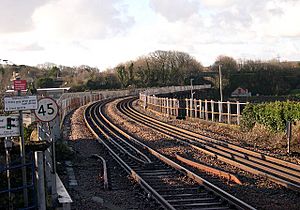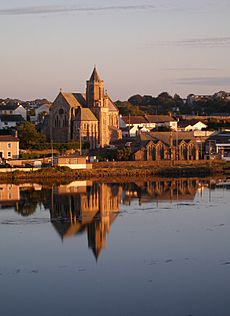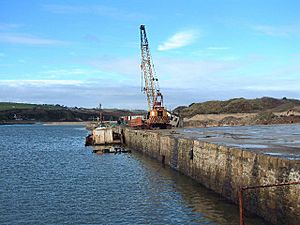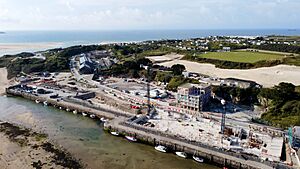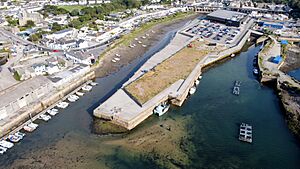Hayle facts for kids
Quick facts for kids Hayle
|
|
|---|---|
| Port Town | |
 Hayle Viaduct from a hill by the estuary mouth |
|
The council's logo |
|
| Lua error in Module:Location_map at line 530: Unable to find the specified location map definition: "Module:Location map/data/Cornwall (mainland)" does not exist. | |
| Population | 9,043 (2021 census) |
| OS grid reference | SW561371 |
| Civil parish |
|
| Unitary authority | |
| Ceremonial county | |
| Region | |
| Country | England |
| Sovereign state | United Kingdom |
| Post town | HAYLE |
| Postcode district | TR27 |
| Dialling code | 01736 |
| Police | Devon and Cornwall |
| Fire | Cornwall |
| Ambulance | South Western |
| EU Parliament | South West England |
| UK Parliament |
|
| Website | Official website: http://www.hayletowncouncil.net |
Hayle (which means "estuary" in Cornish) is a port town and civil parish in west Cornwall, England. It is located where the Hayle River meets St Ives Bay. Hayle is about seven miles (11 km) northeast of Penzance.
The parish of Hayle was created in 1888. It was formed from parts of other parishes like Phillack and St Erth. Today, Hayle shares borders with St Ives to the west and St Erth to the south. To the east are Gwinear and Gwithian. The Celtic Sea forms its northern boundary.
Contents
- Exploring Hayle's Past: A Journey Through Time
- Cornish Wrestling: A Local Tradition
- Hayle Today: A Popular Holiday Spot
- Learning in Hayle: Local Schools
- Media: News and Entertainment
- Twin Town: Connecting with France
- Famous People from Hayle
- See also
Exploring Hayle's Past: A Journey Through Time
How Old is Hayle? Early Settlements and Trade
Even though people have lived around the Hayle Estuary since the Bronze Age, the town we see today mostly grew during the 1700s. This was the time of the Industrial Revolution. We know people lived here long ago because of an Iron Age fort found on a hill above Carnsew Pool.
Hayle was likely a key place for the ancient tin industry. People traded tin not only with Irish and Breton people but also with the Phoenicians from the eastern Mediterranean Sea. We know this from old pottery found here, including Roman and Greek jars used for wine and oil.
Even though the Romans never fully took over Cornwall, they might have had soldiers in the Hayle Estuary area. Some think the rectangular churchyard at St Uny's Church, Lelant was built inside an old Roman fort.
Back then, the estuary looked very different. It was deeper, and boats could travel further up the River Hayle. The tide even reached what is now Foundry Square in the town. At Gwithian, the tide went far inland towards Connor Downs.
The Arrival of Christianity and Medieval Times
After the Romans left, many Christian missionaries came to Cornwall. Most of them were from Ireland. Many Cornish towns are named after these saints. Stories say that Saint Samson and Saint Petroc both arrived in Cornwall at the Hayle Estuary. This shows it was an important port by the late 400s.
However, in the mid-500s, a Breton ruler named Tewdwr Mawr controlled the area. He was said to have killed many Christians before returning to his home around 577.
Old inscribed stones have been found in the area from this time. One important stone was found in 1843 during road construction. It is now in a public park called The Plantation. The stone has Latin writing, but it's hard to read today. Experts believe it says something like: "Here in peace has rested Cunatdo. Here he lies in the tomb. He lived for 33 years."
While Hayle remained a port through the Middle Ages, it was the Industrial Revolution that truly made the town grow into what it is today.
The Domesday survey in 1086 does not mention the town of Hayle. It records the manor of Connerton, which included the Hayle Estuary. This manor was near the village of Gwithian. The name of Connor Downs comes from Conerton.
The first written record of settlements around the Hayle Estuary is from 1130. It mentions Phillack Church and nearby homes as "Egloshayle." This means "the church on the estuary."
Hayle's Industrial Revolution: A Hub of Innovation
Hayle first became important for importing coal and exporting ore. At first, it was smaller than nearby Angarrack, which had a tin smelter built in 1704. Hayle's job was simply to bring in coal from South Wales. This coal was then taken to Angarrack by mule. In 1710, a copper and tin smelter was built at Mellanear Farm.
Building the Port: Quays and Canals
A big step for Hayle was the building of the first modern quay in the 1740s. This was done by John "Merchant" Curnow to help the growing mining industry. In 1758, the Cornish Copper Company (CCCo) moved to Hayle. They set up a copper smelter at Ventonleague (Copperhouse Creek). This was very successful. They even built a canal so ships could come right up to their works. They also bought more land for factories and homes for their workers.
The copper smelting process created a lot of waste. This waste was made into large, dark bricks called "Scoria Blocks." These blocks were very useful for building and were used many times in the town. They were sold cheaply or given free to CCCo workers to build their homes. Sea Lane (now Black Road) was built using these blocks. Waste was also used to fill in parts of Copperhouse Creek, creating Wilson's Pool. Copperhouse Pool was later changed to hold water from the tides. This helped ships reach the dock and also cleaned the channel of sand.
Harvey's Foundry: Powering the World
In 1779, John Harvey, a blacksmith from Carnhell Green, started a small foundry and engineering business. This area is now known as Foundry. His company made tools and machines for the local mining industry. The business grew quickly, employing over 50 people by 1800.
Harvey & Co became famous for making beam engines. These powerful engines were used locally and sent all over the world. One of their largest engines helped drain a huge lake in the Netherlands. It is now in a museum near Schiphol airport. The company also made many other things, from hand tools to ocean-going ships. This included the SS Cornubia and the world's first steam-powered rock drilling machine.
Rivalry and Growth
As Harvey's and the Cornish Copper Company grew, they became rivals. They often argued over who could use the sea. The Cornish Copper Company controlled the main dock and a tidal gate they had built. Harvey's decided to build their own harbor to break this control. They made Penpol Creek deeper and built a new dock. They even created their own tidal pool called Carnsew Pool.
Harvey's also had a "Company Store policy." This meant their workers had to buy their food and supplies from Harvey's own store. This stopped other shops from opening. When this policy ended, many new shops quickly appeared.
Before 1825, if you wanted to go from Hayle to St Ives or Penzance, you had to walk across the sands of the Hayle Estuary. Or you had to take a long detour to cross the River Hayle at the old St Erth Bridge. Guides would lead travelers across the sands, but it was still dangerous. The moving sand and fast tides sometimes caused deaths.
To solve this problem, the Hayle Bridge Causeway Turnpike Trust was formed in 1825. They built the causeway that now carries the road west. It cost £5000 in 1825. People had to pay a toll to use it to help the investors get their money back.
As Hayle became richer, the foundry and smelter owners invested in nearby mines. There was not much mining right in Hayle itself. The closest big mines were around Helston. Hayle's involvement in the Helston mining industry grew so much that in 1833, it became the local tin coinage town. This meant tin was officially weighed and taxed here. However, this system ended in 1838.
Railways and Decline
From 1831 to 1861, the Hayle and Bristol Steam Packet Company ran steamship services. From 1837, these connected with the new Hayle-Redruth Railway. This railway was built to carry both goods and people. Its end point was in Foundry Square, under the current viaduct. Steam engines were used on the Hayle section from 1843. However, the railway's design meant only light engines could be used. The steep slope at Angarrack was also a challenge.
In 1852, a new railway opened. It crossed the valley on the impressive Angarrack viaduct. It passed through Hayle on new wooden supports over Foundry Square. These were later replaced with the stone pillars we see today. The Harbour Branch line closed in 1982. The station buildings and signal box were taken down. This ended direct train links to nearby communities like Praze-an-Beeble and Helston. The original station in Foundry Square was demolished after the Second World War.
Harvey's of Hayle was at its busiest in the early to mid-1800s. But like other factories in Hayle, it slowly started to decline. Harvey's bought the Cornish Copper Company in 1875, but the decline continued. The engineering works and Foundry closed in 1903. The company continued as a general and builders merchant. It later merged with UBM in 1969 to become Harvey-UBM.
Hayle's Lifeboats
The Royal National Lifeboat Institution started a lifeboat station in Hayle in 1866. A boathouse was built in 1897. The station closed in 1920. The boathouse was then used as a storage building for about 60 years before it was taken down. A memorial to Hayle's volunteer lifeboat crews is in the Isis Gardens. This is under the viaduct, where the town's first railway station used to be.
In 1888, the National Explosive works opened on Upton Towans. This area was also called "Dynamite Towans." It first made explosives for local mines. But it soon grew to supply the military. During the First World War, over 1500 people worked there. The remote location on the Towans was a good idea because there were several accidents with explosions.
Hayle in the 20th Century: Changes and New Industries
Explosive making stopped in 1920. However, parts of the site were used to store explosives until the 1960s. Today, this area is a nature reserve looked after by the Cornwall Wildlife Trust.
In 1910, Hayle Power Station opened on Harvey's Towans. It burned coal, which came by ship from South Wales. The power station closed in 1977. At the same time, Hayle Harbour also closed to large commercial ships. However, a local fishing fleet, mainly catching shellfish, continued to operate.
Until the early 1900s, Hayle had two separate areas of settlement around the rival factories. Slowly, buildings started to appear between these two communities. St Elwyn's Church, the Passmore Edwards Institute, and a new Drill Hall were all built around the same time. More housing followed. The Passmore Edwards Institute was one of many libraries and institutes built across Cornwall by its generous founder. The town council used it as offices for many years.
Between the World Wars, some small factories opened on North Quay. These included a glass works, an oil depot, and an ICI plant. This plant made bromine, which was added to fuel for high-power aircraft like Hurricanes and Spitfires. All these factories are now closed, and most of their buildings have been taken down.
The metalworking company J & F Pool, started in 1862, continued to operate in Copperhouse. It made perforated and fabricated metal. Today, the engineering tradition continues with smaller, specialized companies like Bassett Engineering and Rigibore. They focus on tools and precision engineering products from the Guildford Road Industrial Estate. Rigibore sells its tools globally. Bassett Engineering provides engineering services to the Ministry of Defence.
Hayle in the 21st Century: Modern Developments
In autumn 2011, there was a large landslip on the North Cliff. The coastal walking path had to be moved.
Cornish Wrestling: A Local Tradition
Cornish wrestling tournaments have been held in Hayle for at least 200 years. These events, where wrestlers compete for prizes, took place at various locations around the town. Some of these places included Penpol, the Royal Standard Hotel, and the Recreation Ground.
Hayle Today: A Popular Holiday Spot
Hayle's location by the sea and its three miles of golden sandy beaches have made it a popular holiday destination. Many holiday homes, villages, and camping sites are found in the sand dunes, also known as the Towans. The Gwithian beach near Godrevy is very scenic and a favorite spot for water sports like surfing and windsurfing.
Hayle has a local community radio station called Coast FM. It broadcasts on 96.5 and 97.2 FM.
Hayle Harbour: Plans for the Future
Since the 1980s, Hayle Harbour has been the focus of many projects. These projects aim to improve the local economy. In the 1980s, businessman Peter de Savary tried to develop the harbour area. However, he could not get enough money to make his plans happen. Despite other similar plans, the harbour has not yet been fully redeveloped.
In 2004, ING Real Estate, a global property development company, bought Hayle harbour [1]. They started buying land near their planned project area. In April 2008, ING asked for planning permission. As of November 2009, this permission still depended on an agreement about traffic and transport improvements.
Outside the harbour, Hayle has had other successful development projects. The Harveys Foundry project has created new business and residential spaces. This aims to bring more jobs to Hayle. Other plans for the Hayle Area include new shops.
Asda opened a large superstore on the South Quay of Hayle on November 24, 2014. The building's design had to fit into its surroundings. This is because it is in an area that is part of a UNESCO world heritage site. Plans for a new petrol station for the store were submitted in 2017. Future plans for the area include watersports facilities, an arts center, and improved facilities for local fishermen. There are also plans for new bars and restaurants.
Hayle's World Heritage Status

Hayle's town and historic harbour were part of the bid for the Cornwall and West Devon historic mining landscape to become a World Heritage site. On July 13, 2006, it was announced that the bid was successful. The Cornwall and West Devon Mining Landscape was added to the World Heritage list. The Port of Hayle was one of ten important areas within this site.
Getting Around: Transport in Hayle
Hayle railway station is near Foundry Square, at the east end of the viaduct. A footpath, which used to be a railway line, connects it to the harbour. Trains from Great Western Railway and CrossCountry serve the station. You can take local trains to Plymouth or longer journeys to places like London Paddington and Manchester Piccadilly.
National Express also runs three daily bus services from Hayle. They stop at Foundry Square and Copperhouse. These services go to:
- Nottingham, stopping at Camborne, Redruth, Newquay, Bodmin, Plymouth, Bristol, Birmingham, and Leicester.
- London Victoria (two services), stopping at Camborne, Redruth, Truro, St Austell, Liskeard, Plymouth, Taunton, and London Heathrow Airport.
Important Buildings in Hayle
Godrevy Lighthouse, at the eastern end of Hayle Towans, is said to have inspired Virginia Woolf's famous novel To the Lighthouse.
The church of St Elwyn was built between 1886 and 1888. It was designed by J. D. Sedding.
Trevassack Manor is a house from the 1600s or 1700s, with a date stone from 1700. Bodriggy House is made of granite and dates back to around 1710.
Learning in Hayle: Local Schools
The local secondary school for students in Hayle is Hayle Academy.
Media: News and Entertainment
Local TV news for Hayle comes from BBC South West and ITV West Country. TV signals are received from either the Redruth or Caradon Hill TV transmitters.
Local radio stations include BBC Radio Cornwall on 103.9 FM and Heart West on 107.0 FM. Coast FM is a community radio station that broadcasts to the town on 96.5 FM. The town is also served by local newspapers like the St. Ives Times & Echo, The West Briton, and The Cornishman.
Twin Town: Connecting with France
Hayle is twinned with Pordic in Brittany, France. This means the two towns have a special friendship and cultural exchange.
Famous People from Hayle
- John Harvey (1730-1803): An important iron founder, blacksmith, and engineer.
- Henry Jenner (1848–1934): A scholar who studied the Cornish language.
- Kitty Lee Jenner (1853–1936): An artist and writer who helped set up the Cornish Gorsedh.
- Francis Cargeeg (1893–1981): A coppersmith born in Carnsew.
- John Gilbert Cock (1893–1966): Born in Hayle, he was the first Cornish footballer to score for the England national team. He played over 400 professional games.
- Donald Cock (1896–1974): An English footballer who played over 200 professional games.
- Admiral of the Fleet Sir Caspar John (1903–1984): He was the First Sea Lord from 1960 to 1963. He moved to Hayle after retiring and died there.
- Cyril Richard Rescorla (1939–2001): A policeman and soldier born in the town. He served in both British and American armed forces. He sadly died in the attack on the World Trade Center.
- Jean Golding (born 1939): A British epidemiologist, a scientist who studies how diseases spread.
See also
In Spanish: Hayle para niños



